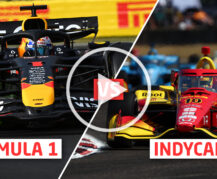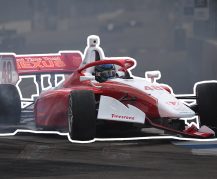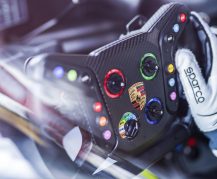Cornering and braking are two of the most important skills that you need to master if you are going to be a successful racing driver. We have chosen a selection of answers from different drivers in our Ask a Pro series that give you an insight into how to improve those skills and make you a better driver.
It seems I hear a number of conflicting philosophies on braking techniques among amateur sports car racers. Could you describe your main technical approaches to braking for corners of different speeds? For example, deciding whether you trail brake, late brake or touch the brakes to settle the car, etc.
Alex Wurz (Former Formula One driver and Le Mans winner): It is impossible to give you one answer. Each car, each tyre, each corner might require a different braking method. Braking methods are something that should not be fixed, as during a race one might have to change the braking method. The brakes are extremely important for the car’s balance, so depending upon what balance you like to have by the turn-in or mid corner, you can change your braking style and brake balance.
For example, if you are racing with high tyre degradation on the rear, you will change your driving line so you will need to change your braking method.
Personally I like to trail brake. As I come off the brake it needs to be timed with turning in. I turn in usually very smooth and come off the brake progressively and coordinate that with the steering and weight transfer of the car – basically making sure that at all times of the braking and cornering I use the maximum possible force the tyre can transmit!
If my car would be nervous on turn-in, I would keep the brake pressure a little longer and move the brake balance a bit forward, so I overload the front tyre and with that I protect/help the rear at the turn-in area. However if you do this, you need to come off the brakes very gently. Otherwise you might create an oversteer at the moment when you come off the brakes when the front tyre is freed of the braking force and has full lateral steering force available instantly. That might cause a sudden oversteer as your front tyre will steer the car and if the rear is still not stable at this point, oversteer is logical….
Well, maybe it gets too complicated now but bottom line, a tyre can transmit a certain amount of forces and you have four tyres. Two of them can steer and four of them can brake so the best braking method is a question of how the rest of the corner looks. I am afraid there is no easy answer.
Can you please explain what is meant by “trail-braking.” Is this the best technique to use?
Gil de Ferran (Multiple Champ Car champion and 2003 Indy 500 winner): To be honest, I never quite understood the terminology! I suppose trail-braking refers to the technique of carrying some brake pressure into the turn.
Possibly the most important part of driving fast is braking – well, that is of course when you don’t have to drive flat-out all the way around! How you brake depends on the type of corner you are approaching, what preceded the braking event, what type of car and tires you are driving, how it is handling, the conditions of your tires, brakes, etc
One has to remember that the brakes not only slow down your speed but also significantly affect the load distribution around the car and, therefore, the handling. So, it is a tool you can use to change the turn-in characteristics of your car, amongst other things.
A good driver MUST understand and feel how best to apply the brakes in different situations and during different phases of the braking zone. It is no good to have a single braking technique; one’s repertoire must encompass various techniques that can be used as needed
What do you find works best for you for pinpointing your braking and turning references? Thanks.
Conor Daly (IndyCar driver): If you do enough research before you get on track you should already have an idea of where you are going to brake. Once you get on track you go to that point and if it’s too early you adjust for that and if it’s too late just bring it back slightly. Turn in points will depend on how you are driving the car and what kind of balance the car has. Sometimes your turn in point will change depending on the balance of the car so you have to be prepared to adjust your driving on the fly.
My biggest problem is I tend to overdrive my corners. I know I should brake earlier and lightly to get on the power prior to the apex, but it seems really hard to do especially when racing with someone. Do you have any advice or hints on the best way to accomplish this?
James Hinchcliffe (IndyCar driver and race winner): At the end of the day, practice makes perfect. The more seat time you spend working on that, the stronger you will be at it. I know it’s hard to think too much about it when you’re out there and focused on driving at the limit, so a good trick is to start a session slow. Do a few laps at 80%, really think through the technique you want to work on, then go 5% faster each lap until you’re back at the limit. Hopefully, going through it a few times at a reduced pace will make it come naturally when you’re flat out.
What is your strategy for negotiating hairpin turns?
J.R. Hildebrand (IndyCar driver): We have actually had a few hairpins this year to work on this, and one of the things that I’ve found to be particularly advantageous in terms of finding lap time is really maximizing the amount of entry speed you carry into a hairpin. In the Indy car, it’s very difficult to put power to the ground in a tight hairpin corner until the car is close to straight out of the corner, and even at that point you’ll still spin the tires some. So even though it seems like you can get the car straighter sooner by turning in late and apexing late, that doesn’t end up equating to much additional exit speed because you still don’t really end up being able to get to full throttle until you’ve gotten your hands almost entirely freed up out at the edge of the track. So instead we have found a noted gain in turning a bit sooner and carrying the deceleration into the corner, using the scrub created by the act of turning even to some extent, to basically get from Point A at the entry of the corner, to Point B where the car is straight and full throttle can be applied at the edge of the road a tenth or two quicker. I’d draw it for you but I’m not quite that handy with just a keyboard. In lower horsepower cars, that is probably slightly less of a necessity, but still certainly something to try if you find you’re lacking a bit of pace.
Do you use reference points for braking, turning, accelerating, etc., or do you focus on visual memory?
Sergio Perez (Formula One driver): No, I use braking references most of the time. We have the marks by meters so I use them as a reference and once you brake, then you start to feel when you should turn, when you should go on power and so on.
Have you had to use degressive braking techniques and which car did you use them in?
Derek Bell (Former Formula One driver and multiple Le Mans winner): I have to say I have never been one to lock up brakes that much but it happens from time to time when in sheer panic you keep your right foot down too hard. In sports cars we always had that compromise to not lock up the wheels otherwise we were going to lose time and have extra tyre changes, as well as the brake wear! As John Wyer used to say, you need: ‘Good hands.’
How do you push your braking point to find the optimal time to brake without ruining your tires?
Karun Chandhok (Former Formula One driver): I think experience counts for a lot with braking. Over time, you learn that an F1 car can brake from a high speed to slow speed in 60 – 70 meters and a LMP Sports car in a 100 meters or a GT car in 150 meters. Your brain develops these references I suppose and then you just tweak it depending on the track, tyres, weather conditions or fuel loads. You also need good feel through your foot to know when the tyres are starting to lock.
For a medium to high-speed turn coming off a long straight – so NO threshold braking and maybe just a lift – how do you gauge braking points and duration and corner entry speed such that you can work up to a consistently fast and safe high-speed turn?
Josef Newgarden (IndyCar driver and race winner): First of all, you’re going to need to understand what type of braking capability the car you are driving has, whether it’s an open-wheel car, sports car or sedan. Once you’ve determined that, I recommend you do a track walk to go around and view the different corners. When you’re doing this, you’re going to want to look for reference points, which will give you a sight picture that you can judge when you’re entering a corner, and build up a picture in your mind so you can work up to the optimal braking point. You can pick cones, for instance. When you are on the track in your race car, if you’re entering a mid-speed corner and they have four cones, then you can start braking at the “four” cone and if that’s too early you can work up to the “three” cone and so on. If there are no cones, you can look for curbs or trees or walls or anything that gives you a visual reference. Then it’s just a question of doing as many laps as you can and working up your corner-entry speed as you gain more experience of each particular turn.
I drive a vintage car in road racing and visit Lime Rock, Watkins Glen, VIR, Summit Point, etc. The car is an Elva MK7S which is a rear engine sports racer from 1964 with four wheel coil-overs and a total weight of 1000 lbs. with 200 hp. Oversteering is the main problem because the weight distribution is 70/30. My question is: when I am in the beginning or middle of a turn and I am carrying too much speed, what is my best fix? When I let off the throttle, the back will come around. When I apply braking the car will understeer and leave the track. Thanks for any help.
Simona de Silvestro (IndyCar driver): You shouldn’t be going into the corner on the throttle, so that may be part of the problem. I don’t usually see any corners where you should have throttle on going in – middle yes (middle to the exit). To me the biggest thing is to brake really late and try to get the slowing down part done as much as you can while you’re going straight, before you start turning the wheel. I’ve always been the kind of driver that carries speed through the corners, so I’m more the type of person that’s going to get into the corner with maybe just a little bit of brake, but getting off the brake really early and letting the car roll so that you’re asking a little bit less from the car. If you add brake then the front tires are going to be under even more pressure because you’re asking the front to turn and to brake at the same time and if you’re accelerating you have to wait until the car is pointed in the right direction. To me the biggest thing is to try to slow down as straight as you can and then as you start releasing the brakes turn into the corner. When you feel the car set then you can apply the throttle.
I’ve been accepted to race in the 2013 Scirocco R-Cup Championship in Europe. The car has a DSG gearbox, so no clutch. Would you advise left-foot braking at all? All cars I have driven prior to this have had a clutch so I have had to right-foot brake. Is there a major advantage by left-foot braking or does it really just depend on driver preference?
Joey Hand (Daytona 24 Hours winner): I would recommend doing what you are most comfortable with, for sure. I am a left-foot braker since I came from karting. Luckily, when I moved to cars, I went directly into formula cars that had “dog” boxes and did not require using the clutch. It wasn’t until I moved to sports cars that I had to learn to use the clutch – and that was only in the Continental Challenge cars that had a stock synchro gearbox from a street car. The only time left-foot braking becomes critical is when the transfer from throttle to brake is really quick. So I’d say LMP cars, Indy cars, DTM and F1, for example. In the BMW M3s in ALMS last year, four of us shared the driving – two left-foot braked and two right-foot braked! It’s all about you and your style. One thing I learned is that right-foot braking can be better for fuel mileage so I had to adapt my left-foot style to ensure I burned a similar amount of fuel as the right-foot guys. I learned this early in my sports car days. So the moral of the story is, even though the car you will drive has no clutch I would stick to what you know. It will probably be better for your apex speed to right-foot brake because the crossover time from brake back to throttle allows the car to roll a bit. Good luck.
 Road Racing Drivers Club
Road Racing Drivers Club
 Share
Share
















